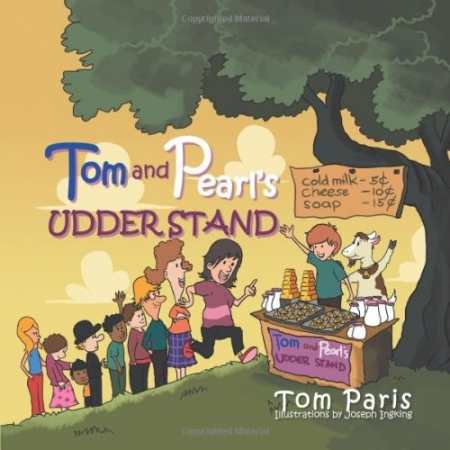Tom and Pearl's Udder Stand
Within America’s increasingly urban population, fewer and fewer children really understand where their food comes from, or the nuts and bolts of how it’s produced. In Tom and Pearl’s Udder Stand, Tom Paris manages to entertain kids while teaching them how milk, cheese, and even soap, among other products, are brought to market.
Tom, a young boy, and Pearl, a talking Nubian goat, discover an old dairy room in the barn. Soon thereafter, with the aid of some old recipes and Pearl’s own milk, they make soap and cheese, and they set up Tom and Pearl’s Udder Stand, a small roadside dairy depot.
Paris is thoroughly familiar with explaining ecosystems and the natural environment to children, having worked as a writer of children’s environmental shows and an educator focused on endangered animals. Tom and Pearl’s Udder Stand is reminiscent of Tomie dePaola’s Charlie Needs a Cloak in the way it details the step-by-step processes involved, except instead of making a new cloak, Paris shows kids how to milk a goat and use cheesecloth.
Paris does a nice job of delivering lots of information without losing sight of Tom and Pearl’s—not to mention any young readers’—sense of wonder and discovery: “‘you didn’t know goat’s milk was different from any other milk and was used for hundreds of years in soaps to wash dirty kids like you and me?’ asked Pearl. Tom looked at Pearl and said, ‘Can you eat it?’ Pearl laughed as they continued to explore their new secret dairy room.”
For Tom and Pearl, the dairy room is like a secret museum, and their discoveries, though seemingly pedestrian, are as exciting as any mystery. Joseph Ingking’s illustrations are friendly and charming throughout the book, but also provide critical details when needed: cobwebs in a long-forgotten room, or an urban skyscape outside Tom’s bedroom window.
The book’s ending, which reveals that Tom is actually in bed at home with his stuffed animal goat, Pearl, having dreamed the entire story, seems tacked-on and unnecessary. Children would have no problem suspending disbelief and accepting a talking goat. However, it is tough to believe that a child would dream about recipe ingredients that include lye and other chemicals.
With all of the children’s books that spawn endless sequels, Tom and Pearl’s Udder Stand is one for which more installments would be welcome. Whether Paris’s expertise extends to other aspects of farming is unknown, but children would benefit from knowing how food actually gets to their kitchen tables.
Reviewed by
Peter Dabbene
Disclosure: This article is not an endorsement, but a review. The publisher of this book provided free copies of the book and paid a small fee to have their book reviewed by a professional reviewer. Foreword Reviews and Clarion Reviews make no guarantee that the publisher will receive a positive review. Foreword Magazine, Inc. is disclosing this in accordance with the Federal Trade Commission’s 16 CFR, Part 255.

